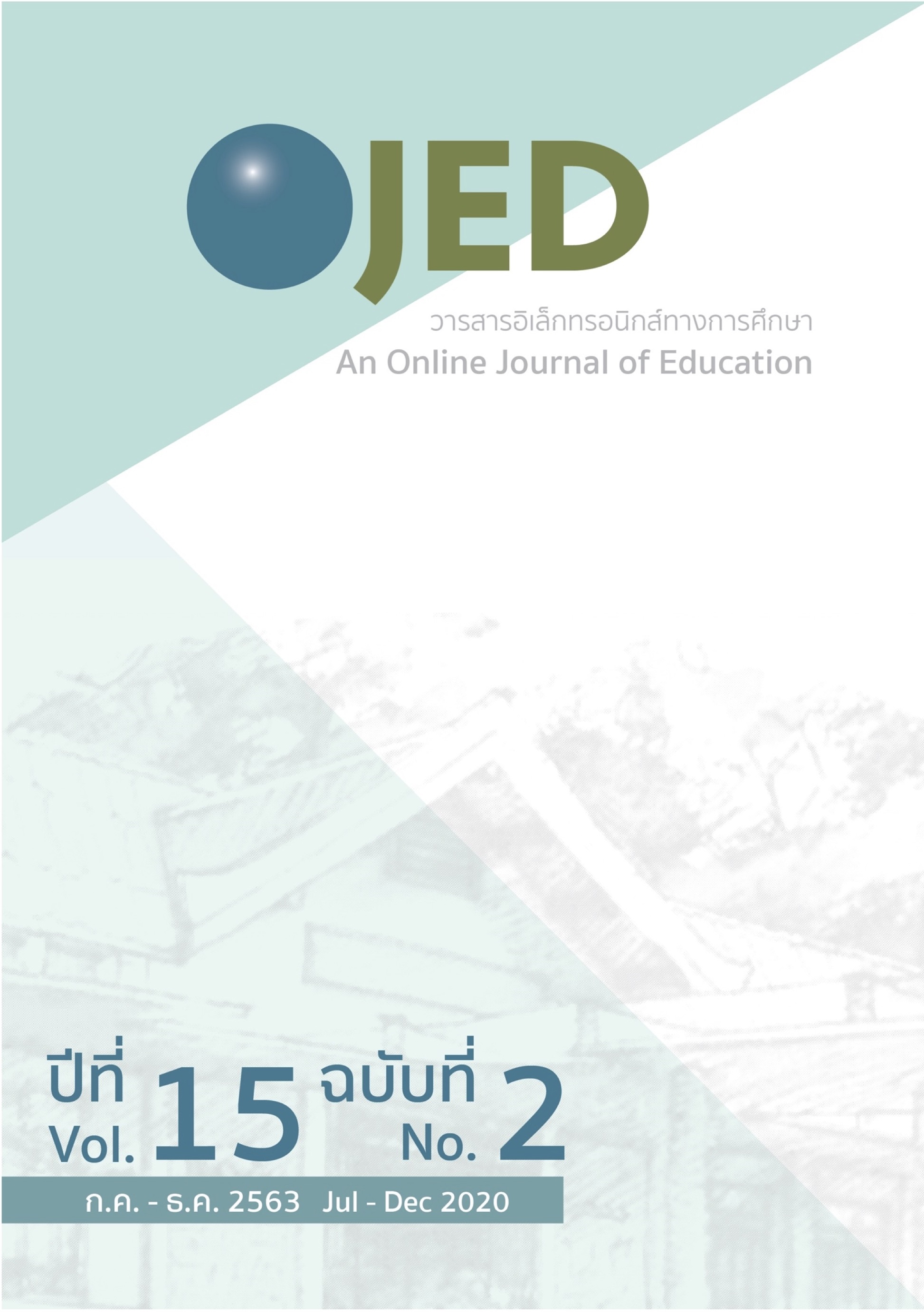Priority Needs for Teacher Development in Dipangkornwittayapat School Cluster under Royal Patronage, based on the Happy School Concept
DOI:
https://doi.org/10.14456/ojed.2020.24Keywords:
happy school, teacher developmentAbstract
This is a descriptive research that aimed to analyze the priority needs for teacher development in the Dipangkornwittayapat School Cluster under Royal Patronage, based on the Happy School concept. The population comprised the Dipankornwittayapat School Cluster under Royal Patronage. The informants were directors, deputies and teachers. The research instruments were rating scale questionnaires. The data was analyzed by frequency, distribution, percentage, mean, standard deviation and PNImodified
The research identified that the current stage of teacher development in the Dipangkornwittayapat School Cluster under Royal Patronage, based on the Happy School concept; Overall was the high level (M = 3.532), while the desirable state is the highest (M = 4.519). The needs with the highest priority are the Need for Teacher Skills and Competencies (PNImodified = 0.375), followed by Learning as a team between students and teachers (PNImodified = 0.316), and Teamwork and Collaborative spirit (PNImodified = 0.311), respectively.
References
กนิน แลวงค์นิล. (2562). แนวทางการพัฒนาสมรรถนะของครูใหม่สังกัดสำนักงานเขตพื้นที่การศึกษามัธยมศึกษา เขต 2 ตามแนวคิดการพัฒนาครูโดยโรงเรียนเป็นฐาน. วารสารการบริหารและนวัตกรรมการศึกษา, 2(1), 1-19.
กรมวิชาการ. (2541).ทฤษฎีการเรียนรู้อย่างมีความสุข. วัฒนาพานิช.
กลุ่มโรงเรียนในพระราชูปถัมภ์ฯ. (2562). รายงานการประเมินตนเองของสถานศึกษาในกลุ่มโรงเรียนทีปังกรวิทยาพัฒน์ในพระราชูปถัมภ์ฯ ประจำปีการศึกษา 2561. กลุ่มโรงเรียนในพระราชูปถัมภ์ฯ.
ข้อบังคับคุรุสภาว่าด้วยใบอนุญาตประกอบวิชาชีพ. (2562, 26 พฤษภาคม). ราชกิจจานุเบกษา. เล่ม 136 ตอนพิเศษ 291 ง. หน้า18-20.
จักรพงษ์ ทัพขวา. (2531). บทบาทในการพัฒนาบุคลากรของผู้บริหารโรงเรียนมัธยมศึกษาขนาดใหญ่ เขตการศึกษา 9 ตามการรับรู้ของผู้บริหารและครูอาจารย์ [วิทยานิพนธ์ปริญญามหาบัณฑิต ไม่ได้ตีพิมพ์]. จุฬาลงกรณ์มหาวิทยาลัย.
ชวนคิด มะเสนะ. (2559). การพัฒนาทรัพยากรบุคคลทางการศึกษาในทศวรรษหน้า. วารสารบริหารการศึกษาบัวบัณฑิต มหาวิทยาลัยราชภัฏอุบลราชธานี, 16(1), 9-16. https://so01.tci-thaijo.org/index.php/buajead-ubru/article/view/63645
โชติชวัล ฟูกิจกาญจน์. (2556). กระบวนการพัฒนาทรัพยากรมนุษย์เชิงกลยุทธ์. วารสารมนุษยศาสตร์และสังคมศาสตร์, 4(1), 33-45.
ทิศนา แขมมณี. (2545). ศาสตร์การสอน. สำนักพิมพ์แห่งจุฬาลงกรณ์มหาวิทยาลัย.
ธารารัตน์ มาลัยเถาว์. (2558). กลยุทธ์การพัฒนาครูประถมศึกษาตามแนวคิดการเรียนรู้ด้วยการนำตนเองและการจัดการศึกษาไปสู่การพัฒนาสังคมที่ยั่งยืน [วิทยานิพนธ์ปริญญามหาบัณฑิต ไม่ได้ตีพิมพ์]. จุฬาลงกรณ์มหาวิทยาลัย.
นฤมล หน่อนิล. (2554). ผลของการใช้โปรแกรมการเรียนโดยใช้ปัญหาเป็นฐานที่มีต่อความสามารถในการทำงานเป็นทีมของนักเรียนมัธยมศึกษาตอนต้น [วิทยานิพนธ์ปริญญามหาบัณฑิต]. Chulalongkorn University Intellectual Repository (CUIR). http://cuir.car.chula.ac.th/handle/123456789/22431
นิสดารก์ เวชยานนท์. (2548). การบริหารทรัพยากรมนุษย์ [เอกสารไม่ได้ตีพิมพ์]. คณะรัฐประศาสนศาสตร์ สถาบันบัณฑิตพัฒนบริหารศาสตร์.
พระธรรมปิฎก. (ป.อ.ปยุตฺ.โต.). (2538). ชีวิตที่สมบูรณ์. สหธรรมิก.
พิณพนธ์ คงวิจิตต์. (2557). ผลของการจัดกิจกรรมการเรียนรู้ภาษาไทยโดยใช้รูปแบบการสอนเบรนทาร์เก็ตที่มีต่อความสุขในการเรียนและความคงทนในการเรียนรู้ของนักเรียนมัธยมศึกษาปีที่ 1. วารสารอิเล็กทรอนิกส์ทางการศึกษา, 9(1), 297-311.
มารุต พัฒผล. (2557). การจัดการเรียนรู้ที่เสริมสร้างการรู้คิดและความสุขในการเรียนรู้. จรัลสนิทวงศ์การพิมพ์.
สืบสกุล นรินทรางกูร ณ อยุธยา. (2563). การบริหารทรัพยากรมนุษย์ทางการศึกษาแนวใหม่. สำนักพิมพ์แห่งจุฬาลงกรณ์มหาวิทยาลัย.
สุวิมล ว่องวาณิช. (2558). การวิจัยประเมินความต้องการจำเป็น. สำนักพิมพ์แห่งจุฬาลงกรณ์มหาวิทยาลัย.
สำนักงานคณะกรรมการการศึกษาแห่งชาติ. (2545). ทฤษฎีการเรียนรู้อย่างมีความสุข. วัฒนาพานิช.
สำนักเลขาธิการสภาการศึกษา. (2553). ข้อเสนอการปฏิรูปการศึกษาในทศวรรษที่ 2 (พ.ศ. 2552–2561) (พิมพ์ครั้งที่ 4). พริกหวานกราฟฟิค.
Castetter, W. B., & Young, I. P. (2000). The human resources function in education administration (7nd ed). Prentice-Hall.
Dessler, G. (2013). Human resource management (13th Edition). Pearson.
Organisation for Economic Co-operation and Development [OECD]. (2019). The Profressional Development of Teachers. https://www.oecd.org/berlin/43541636.pdf
Phelan, R. J. (1999).The relationship between student and teacher perceptions of the organization climate of their school. Dissertation Abstracts International, 59(7), 228.
Rabin, R. (2014). Blended learning for leadership. Center for Creative Leadership. http://www.thecompleteleader.org/sites/default/files/imce/BlendedLearningLeadership.pdf
The Children Society. (2019). The good childhood report 2019. https://www.childrenssociety.org.uk/sites/default/files/the_good_childhood_report_2019.pdf
UNESCO. (2016). Happy School! A Framework for Learner Well-being in the Asia-Pacific. http://unesdoc.unesco.org/images/0024/002441/244140e.pdf
Yamane, T. (1967). Statistics, An introductory analysis.(3rd Ed.). Harper and Row.
Downloads
Published
How to Cite
Issue
Section
License
Copyright (c) 2020 An Online Journal of Education

This work is licensed under a Creative Commons Attribution-NonCommercial-NoDerivatives 4.0 International License.




